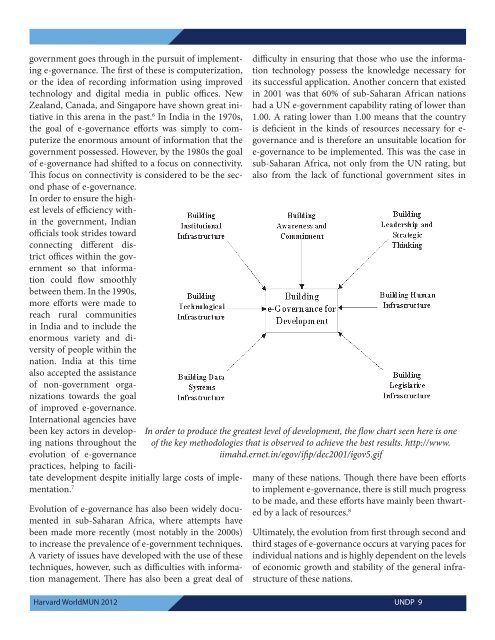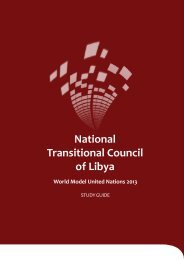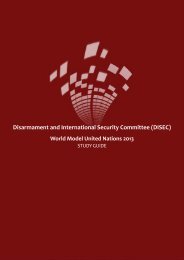Study Guide - World Model United Nations
Study Guide - World Model United Nations
Study Guide - World Model United Nations
You also want an ePaper? Increase the reach of your titles
YUMPU automatically turns print PDFs into web optimized ePapers that Google loves.
government goes through in the pursuit of implementing<br />
e-governance. The first of these is computerization,<br />
or the idea of recording information using improved<br />
technology and digital media in public offices. New<br />
Zealand, Canada, and Singapore have shown great initiative<br />
in this arena in the past. 6 In India in the 1970s,<br />
the goal of e-governance efforts was simply to computerize<br />
the enormous amount of information that the<br />
government possessed. However, by the 1980s the goal<br />
of e-governance had shifted to a focus on connectivity.<br />
This focus on connectivity is considered to be the second<br />
phase of e-governance.<br />
In order to ensure the highest<br />
levels of efficiency within<br />
the government, Indian<br />
officials took strides toward<br />
connecting different district<br />
offices within the government<br />
so that information<br />
could flow smoothly<br />
between them. In the 1990s,<br />
more efforts were made to<br />
reach rural communities<br />
in India and to include the<br />
enormous variety and diversity<br />
of people within the<br />
nation. India at this time<br />
also accepted the assistance<br />
of non-government organizations<br />
towards the goal<br />
of improved e-governance.<br />
International agencies have<br />
been key actors in developing<br />
nations throughout the<br />
evolution of e-governance<br />
practices, helping to facilitate<br />
development despite initially large costs of implementation.<br />
7<br />
Evolution of e-governance has also been widely documented<br />
in sub-Saharan Africa, where attempts have<br />
been made more recently (most notably in the 2000s)<br />
to increase the prevalence of e-government techniques.<br />
A variety of issues have developed with the use of these<br />
techniques, however, such as difficulties with information<br />
management. There has also been a great deal of<br />
Harvard <strong>World</strong>MUN 2012<br />
difficulty in ensuring that those who use the information<br />
technology possess the knowledge necessary for<br />
its successful application. Another concern that existed<br />
in 2001 was that 60% of sub-Saharan African nations<br />
had a UN e-government capability rating of lower than<br />
1.00. A rating lower than 1.00 means that the country<br />
is deficient in the kinds of resources necessary for egovernance<br />
and is therefore an unsuitable location for<br />
e-governance to be implemented. This was the case in<br />
sub-Saharan Africa, not only from the UN rating, but<br />
also from the lack of functional government sites in<br />
In order to produce the greatest level of development, the flow chart seen here is one<br />
of the key methodologies that is observed to achieve the best results. http://www.<br />
iimahd.ernet.in/egov/ifip/dec2001/igov5.gif<br />
many of these nations. Though there have been efforts<br />
to implement e-governance, there is still much progress<br />
to be made, and these efforts have mainly been thwarted<br />
by a lack of resources. 8<br />
Ultimately, the evolution from first through second and<br />
third stages of e-governance occurs at varying paces for<br />
individual nations and is highly dependent on the levels<br />
of economic growth and stability of the general infrastructure<br />
of these nations.<br />
UNDP 9

















